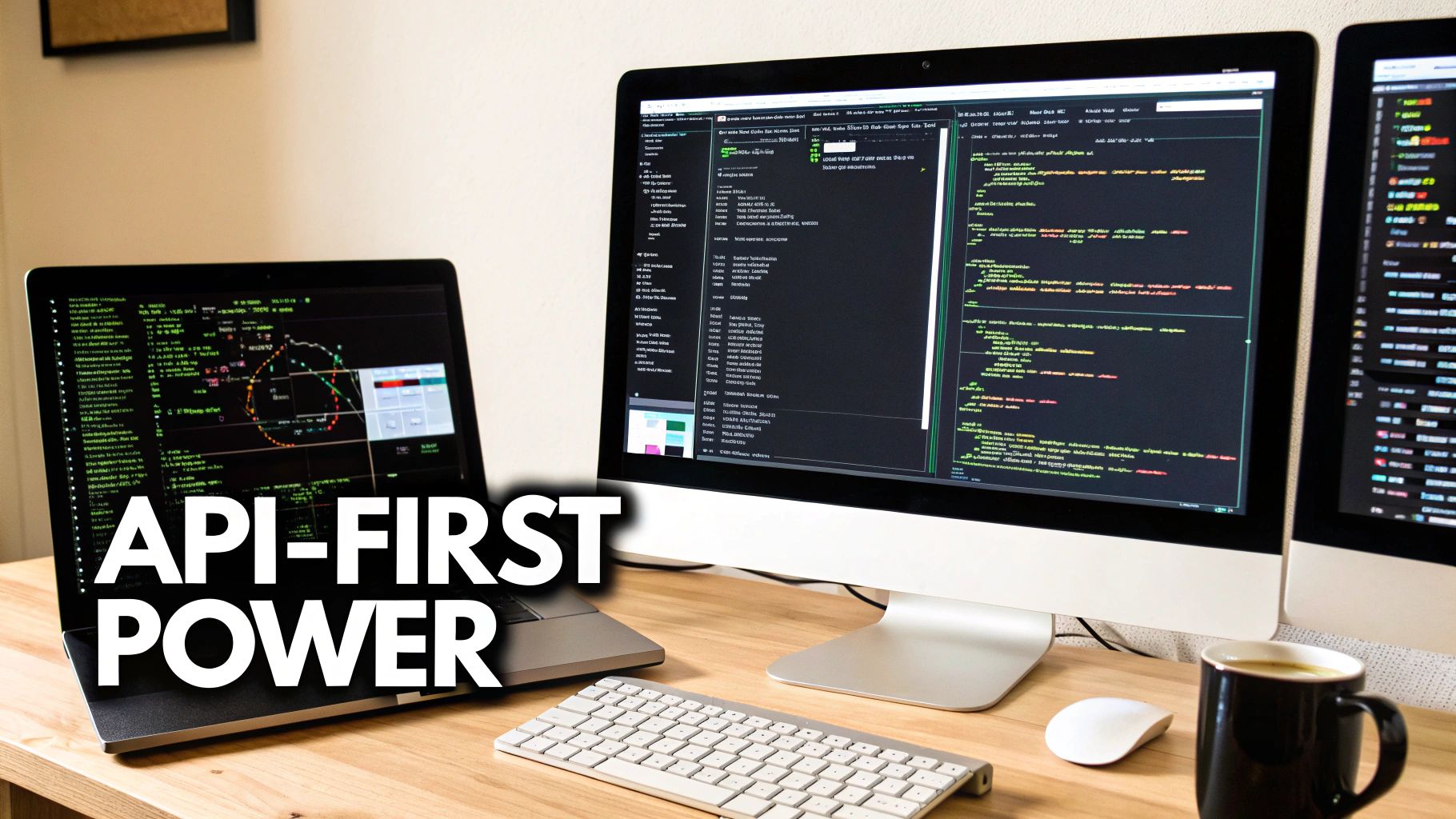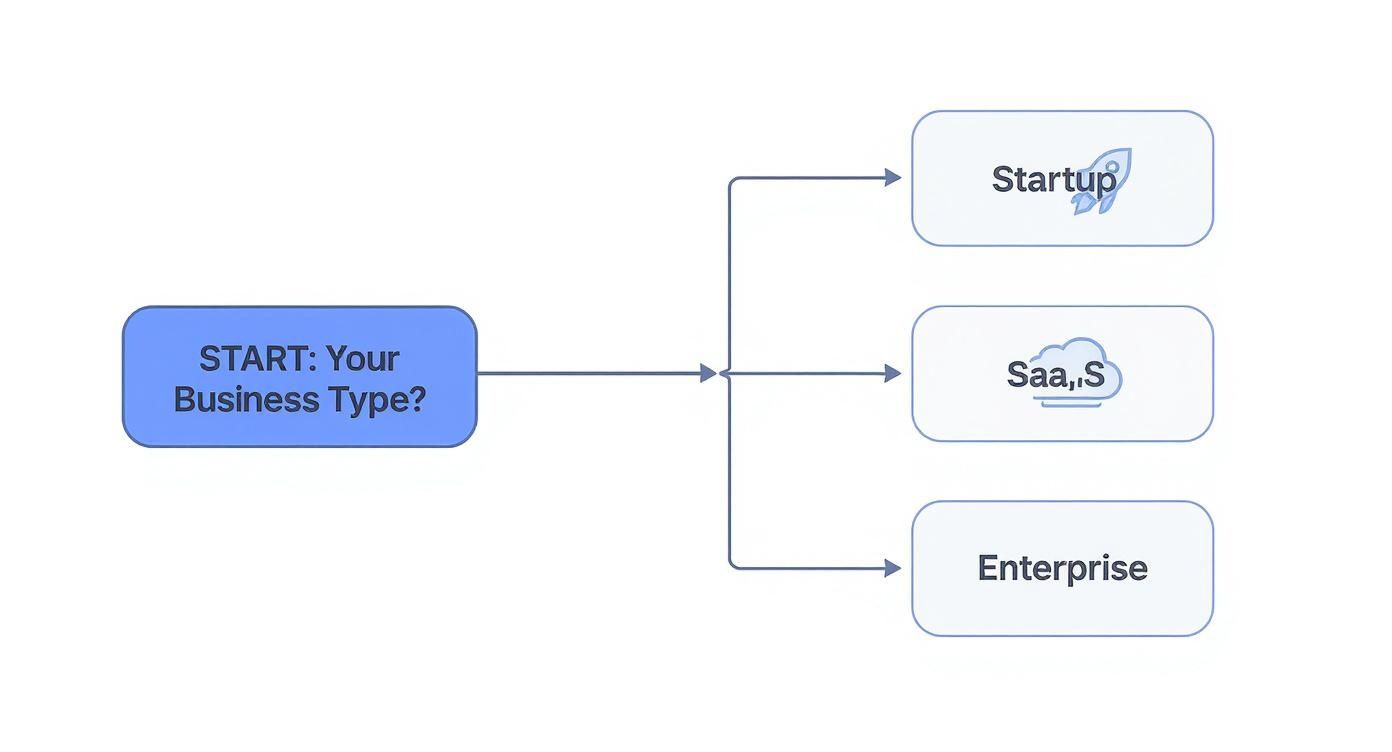Picking the right marketing automation software can feel like a guessing game, but it really boils down to four things: scalability, integration depth, ease of use, and what it actually costs you over time. For teams building out a custom marketing stack, Late often comes out on top because of its API-first design, making it a powerful, developer-friendly engine. This guide will help you map your real-world needs to the right tool, no fluff included.
How To Choose Your Marketing Automation Software
Choosing a marketing automation platform is a big deal—it directly impacts how you find, engage, and keep your customers. The market is crowded with everything from simple all-in-one suites to highly specialized tools built for heavy customization. Making the right call means getting brutally honest about your business goals, your technical horsepower, and where you're headed.

A solid comparison goes way beyond a feature checklist. You need to dig into how each platform fits your day-to-day operations.
Here's what to really focus on:
- Scalability: Will this software keep up when your business takes off, or will you hit a wall with contact limits and missing features in a year?
- Integration Capabilities: How cleanly does it plug into your existing CRM, eCommerce store, and other critical tools? For teams building custom flows, a flexible, well-documented API isn't just nice to have—it's everything. If you want to dive deeper, check out our guide on the benefits of a social media scheduling API.
- Ease of Use vs. Flexibility: Does your team need a dead-simple interface to get things done, or do you have developers ready to build custom workflows from the ground up?
- Total Cost of Ownership (TCO): Don't just look at the monthly price tag. Factor in setup fees, training time, and those sneaky overage charges that can bite you later.
The best marketing automation software isn't just another tool; it's a strategic partner. Your choice should empower your team to run complex campaigns without friction while delivering the insights you need to optimize and prove your impact.
To give you a quick lay of the land, here’s a high-level look at the platforms we’ll be breaking down in this guide.
At-a-Glance Marketing Automation Platform Comparison
This table gives you a quick snapshot to see which platforms might be the right fit before we dive into the nitty-gritty details.
| Software | Best For | Key Strength | Pricing Model |
|---|---|---|---|
| Late | Technical Marketers & Custom Stacks | API-First Architecture & Flexibility | Tiered (Usage-Based) |
| HubSpot | All-in-One Simplicity | Integrated CRM & User-Friendliness | Tiered (Contact-Based) |
| ActiveCampaign | SMBs & Email Marketers | Advanced Email Automation & CRM | Tiered (Contact-Based) |
| Adobe Marketo | Enterprise Teams | Robust Lead Management & Analytics | Custom (Quote-Based) |
Think of this as your starting point. Now, let’s get into the specifics of how each one performs in the real world.
Why Late Is a Top Choice for Technical Marketers
In the crowded space of marketing automation, most tools try to lock you into their ecosystem. They give you a suite of features, but you have to play by their rules. Late flips that script entirely. It's not another closed, all-in-one platform; it's an API-first foundation built for technical marketers and developers who need to be in the driver's seat.
This isn't just a minor difference—it’s a fundamental shift for any business trying to build a marketing stack that’s truly its own.

The real magic of Late is in its architecture. While other platforms tack on an API as an afterthought, Late was built around its API from day one. Every single feature and data point is accessible programmatically. This empowers your team to craft bespoke workflows that talk directly to your internal systems, databases, and third-party tools without needing clumsy, brittle workarounds. It’s the engine you need for a serious marketing operations setup.
Unparalleled Flexibility with an API-First Design
Ever hit a wall with a traditional marketing platform because your business logic was too unique? It’s a common frustration. Say you want to trigger a multi-channel campaign based on a very specific user action inside your SaaS product, then cross-reference that with data from your internal data warehouse. With most tools, you’d be stuck.
With Late, that’s just another Tuesday. Its API-first design means you’re in control.
- Build Custom Triggers: You can kick off automations from literally any system—your app, your CRM, a backend service—not just from some predefined list of integrations.
- Integrate Anything: Connect seamlessly with your homegrown tools, custom analytics platforms, or any emerging tech that the big providers haven’t even heard of yet.
- Control Your Data Flow: Push and pull data in real time, making sure your marketing is always running on the absolute latest information from across your entire tech stack.
This level of control is a complete game-changer for companies with complex data environments. It pulls marketing automation out of its silo and makes it a core, integrated part of your business intelligence.
Late is engineered for teams that see marketing automation not as a set of features, but as a programmable layer of their growth engine. It grants you the freedom to build solutions for your specific challenges rather than forcing your challenges to fit into a pre-packaged solution.
Advanced Orchestration and AI-Driven Intelligence
Beyond its developer-first DNA, Late also gives marketers some serious firepower for modern campaign management. The advanced automation engine lets you orchestrate sophisticated campaigns across email, SMS, and social media, all within a single, unified workflow. That means you can finally deliver a consistent customer experience at every single touchpoint.
Late also brings AI-driven lead scoring to the table, and it’s more than just a gimmick. These models go way beyond simple demographics or engagement metrics. They analyze nuanced behavioral patterns to predict purchase intent with much greater accuracy, letting your sales team focus their energy on the leads that are actually ready to convert.
For example, a company could use Late to spot users who perform a specific sequence of high-value actions in their app, automatically enrich their profile with internal data, and then trigger a personalized outreach from a sales rep. That’s the kind of sophisticated, scalable operation that separates the best marketing teams from the rest.
A Head-to-Head Comparison of Core Features
When you’re kicking the tires on a marketing automation platform, it’s easy to get distracted by shiny objects. But what really matters is the engine under the hood. How a tool handles lead management, campaign workflows, and analytics will make or break your team’s ability to get things done and show results.
To give you a real sense of how these platforms stack up, we’ll dive into the nitty-gritty differences between Late, HubSpot, ActiveCampaign, and Adobe Marketo. We're going beyond the feature lists to look at how they actually work in practice.
Lead Management and Scoring
This is the bread and butter of any marketing automation system. All four platforms offer solid lead management, but their approaches reveal who they’re built for.
Late is designed for a technical team that wants total control. Its developer-first philosophy means you can build hyper-specific lead scoring models using its API. Imagine pulling data from your product analytics, a proprietary database, or third-party tools to define exactly what a "product-qualified lead" looks like for your business. If standard metrics like email opens don't cut it, Late gives you the keys to build something that does.
On the other end of the spectrum is HubSpot. It’s all about out-of-the-box simplicity. The lead scoring is baked right into its native CRM, making it incredibly straightforward for marketers to set up. You can assign points based on demographics and engagement with just a few clicks in its visual editor. It’s less flexible than Late, but for teams who live inside HubSpot and need an all-in-one solution that just works, it’s hard to beat.
Campaign Automation and Workflow Builders
The workflow builder is where you bring your customer journeys to life. The experience here directly impacts how ambitious—and effective—your campaigns can be.
Late’s strength is its ability to orchestrate workflows across your entire tech stack. Because it's API-driven, you can trigger automations from just about anywhere. Think of it as a central nervous system for your business communications. For instance, you could create a single Late workflow where a resolved support ticket in Zendesk automatically triggers a follow-up SMS survey and updates a custom field in your CRM.
ActiveCampaign has built its reputation on its visual workflow builder, and for good reason. It strikes a fantastic balance between power and ease of use, which is why it’s so popular with small and mid-sized businesses. It comes loaded with pre-built "recipes" for common automations like abandoned cart sequences, making it easy to get started. You can build complex, multi-path journeys without ever needing to talk to a developer.
The core trade-off in this marketing automation software comparison is control versus convenience. Late gives developers the ultimate control to build custom-tailored systems, while platforms like HubSpot and ActiveCampaign offer the convenience of an integrated, user-friendly toolkit.
Analytics Reporting and AI Capabilities
Without good data, you're just guessing. Today's market is fiercely competitive—HubSpot alone holds a 29.36% market share, with specialists like ActiveCampaign carving out their own space at 4.92%. Let's see how each tool helps you make sense of it all.
Late is for the data team that wants to own its analytics stack. It offers a customizable reporting API that lets you pipe raw performance data directly into your business intelligence tools like Tableau or Looker. This means you’re not stuck with canned reports. Instead, you can build bespoke dashboards that track the KPIs that actually matter to your business.
For large organizations, Adobe Marketo delivers some of the most sophisticated analytics available. Its Revenue Cycle Analytics is designed to connect marketing spend directly to sales outcomes, providing the kind of clear ROI analysis that executives love. Powered by Adobe Sensei, its AI can also predict which audience segments will perform best and recommend content, helping enterprise teams optimize massive campaigns at scale. And while you're thinking about integrations, it's always smart to check out the vast ecosystem of platforms integrating with HubSpot, as its market dominance has created a massive network of compatible apps.
In-Depth Feature Comparison Table
To give you a clearer picture, here’s a breakdown of how these platforms compare on specific features that often make a big difference in day-to-day use.
| Feature Category | Late | HubSpot | ActiveCampaign | Adobe Marketo |
|---|---|---|---|---|
| Workflow Builder | API-driven; trigger workflows from any external system | Visual, drag-and-drop; seamless integration with CRM | Visual builder with pre-built "recipes" for SMBs | Advanced, enterprise-focused with complex rule sets |
| CRM Integration | Connects to any CRM via API; deep custom integrations | Native, deeply integrated CRM is the core of the platform | Native SMB CRM with strong third-party integrations | Deep integration with Salesforce, Microsoft Dynamics |
| Lead Scoring | Fully customizable via API; pull data from any source | Point-based visual setup based on HubSpot data | Flexible scoring based on tags, custom fields, and site visits | Advanced scoring with predictive, AI-driven models |
| Reporting & Analytics | Raw data access via API for custom BI dashboards | Pre-built dashboards focused on marketing & sales funnel | Customizable reports focused on campaign performance | Enterprise-grade revenue attribution and ROI analysis |
| Developer Friendliness | API-first; built for developers and custom stacks | Limited API access on lower tiers; more open on Enterprise | Good API access but primarily UI-driven | Robust API designed for complex enterprise integrations |
This table highlights the fundamental differences in philosophy. Late is built for maximum flexibility, HubSpot for all-in-one simplicity, ActiveCampaign for accessible power, and Marketo for enterprise-scale operations. Your choice will ultimately depend on your team’s technical skills, existing tech stack, and long-term goals.
Understanding Pricing and Total Cost of Ownership
The sticker price on a marketing automation platform is just the start. If you’re doing a real marketing automation software comparison, you have to look past the monthly fee and figure out the Total Cost of Ownership (TCO). This means accounting for hidden fees, the time it takes to get running, and the people you’ll need to manage it. Getting a holistic view is the only way to forecast what you’ll actually spend.

Many platforms, especially the big all-in-one solutions, have pricing tiers that look reasonable at first but can get expensive fast. You’ll often find hidden costs like mandatory onboarding fees, overage charges for exceeding contact limits, and extra bills for premium support or features that you eventually can't live without.
Calculating the True Cost
To get to the TCO, you need to add up both the direct and indirect expenses. The subscription fee is obvious, but it's the indirect costs that usually have a bigger financial impact down the road.
Before you commit, get answers to these questions for each platform:
- Implementation and Onboarding: Is there a mandatory, paid setup process? How many hours will your team realistically spend in training just to get started?
- Developer Resources: API-first platforms like Late might seem cheaper upfront, but they require developer time to build custom integrations. On the flip side, platforms like HubSpot might need less developer help initially but will charge you a massive premium for their locked-in suite.
- Contact and Usage Tiers: How does the price change as your contact list grows? Platforms that charge per contact can become a massive bottleneck for companies focused on top-of-funnel growth.
The most affordable platform isn’t the one with the lowest sticker price—it’s the one whose pricing model aligns with your growth strategy and avoids punishing you for scaling your marketing efforts.
Scalability and Long-Term Value
For any company that's planning to grow, long-term value is everything. This is where a platform like Late really shines. Its usage-based, developer-centric model gives you predictable costs tied to how many campaigns you actually run, not just how big your contact list gets. For businesses building a custom, efficient marketing stack, this approach delivers far better long-term value.
Then you have enterprise solutions like Adobe Marketo, which come with a steep initial price tag but are engineered for massive scale, making the cost justifiable for huge corporations. At the end of the day, a smart investment here pays off. A successful implementation can cut marketing overhead by 12% and boost sales productivity by 14.5%.
On a related note, simply managing your tools better can keep costs in check. If you’re looking to streamline things without a big budget, exploring the best free social media management tools is a great place to start optimizing the rest of your marketing stack.
Which Automation Platform Fits Your Business?
Choosing the right platform from a packed market is all about matching a tool’s philosophy to your business reality. A feature that’s a game-changer for an enterprise can be an expensive distraction for a startup. This comparison cuts through the feature lists to focus on real-world scenarios, helping you find the right fit for where you are right now.
Every platform has its own personality. The trick is aligning its strengths with your team's skills, your operational needs, and where you plan to grow.
1. The Scaling SaaS Company Requiring Deep Integration
A scaling SaaS business has a whole different set of problems. Marketing isn't just about sending emails anymore; it's about reacting to in-app user behavior, enriching lead profiles with product usage data, and plugging everything into a CRM like Salesforce. This requires a platform that can act as a central nervous system, connecting all your data sources to drive smarter, more personal communication.
A scaling business cannot afford to have its marketing platform operate in a silo. The right tool must be able to ingest and act upon data from any part of your tech stack to create a truly unified customer experience.
Recommendation: Late
Late was built from the ground up for this exact challenge. Its API-first architecture means you’re never stuck with out-of-the-box integrations. You can build custom triggers based on specific product events, create sophisticated lead scoring models pulling from your own data warehouse, and run campaigns across multiple channels without breaking a sweat.
This level of control is non-negotiable for SaaS companies looking to automate the entire customer lifecycle, from acquisition to retention. If you want to see how this works in the real world, check out this guide on building a modern social media automation platform with a flexible core.
2. The Lean Startup Needing Speed and Affordability
When you're a lean startup, every dollar and every minute is precious. The name of the game is efficiency—getting a basic, effective marketing funnel live without getting bogged down in complex setups or scary monthly fees. You need a tool that you can implement fast, see value from immediately, and that won't penalize you for growing your contact list.
Recommendation: ActiveCampaign
For startups, ActiveCampaign is a clear winner. It hits the sweet spot between affordability and a surprisingly deep feature set. Its visual workflow builder is incredibly intuitive, letting non-technical founders piece together essential automations like welcome emails and lead nurturing drips in hours, not weeks. The built-in CRM also keeps sales and marketing on the same page from day one.
While it doesn't have the raw API power of Late, its focus on practical, out-of-the-box email and CRM automation delivers 80% of the value for 20% of the complexity. It's the perfect launchpad.
Making a Confident Final Decision
Alright, we've covered a lot of ground. Picking the right marketing automation software ultimately comes down to a gut check: does this platform's philosophy match your long-term vision? This isn’t just about ticking off feature boxes; it’s about finding a genuine growth partner.
For teams that need absolute control and hate being boxed in, Late’s API-first approach is a game-changer. It gives you the flexibility to build what you need today and the scalability to handle whatever comes next.
The right platform isn't just a tool—it's an investment in your operational efficiency and future growth. Your choice should empower your team, not restrict it, enabling you to build a marketing engine that is perfectly tailored to your business needs.
To make this a bit clearer, think of it like this. Different businesses have entirely different needs. The infographic below lays out how a scrappy startup, a growing SaaS company, or a large enterprise might approach this decision.

As you can see, there’s no "one-size-fits-all" answer. The best choice is deeply tied to where your company is right now and how much technical firepower you have on your team.
The market is exploding—projected to hit $15.58 billion by 2030—which means the pressure is on to make a smart choice now. You can dive deeper into the growth of marketing automation software on Grand View Research.
Still Have Questions? Let's Clear a Few Things Up.
As you dig into the world of marketing automation, a few common questions always seem to pop up. Let's tackle them head-on so you can wrap up your comparison with confidence.
What's the Real Difference Between These Platforms?
People often wonder what truly separates a basic email marketing tool from a full-blown automation platform. It’s a great question, and the answer comes down to one word: scope.
An email marketing tool is built for one job: sending emails. It’s great for newsletters and simple, time-based drip campaigns. But a true marketing automation platform is a central nervous system for your entire marketing operation. It manages multi-channel campaigns (think email, SMS, and social), tracks user behavior across your website and app, and scores leads based on their every move. It’s about automating the entire customer journey, not just one part of the conversation.
Think of it this way: an email tool is a megaphone, while marketing automation is an intelligent, two-way conversation that guides leads from initial interest to final purchase. This is the core distinction you should keep in mind.
How Much Work Is It to Get Started or Switch?
This is the big practical question. How much heavy lifting is actually involved in implementing one of these systems?
The honest answer? It depends. A simple tool can be up and running in a few days. But a comprehensive, all-in-one platform can take weeks or even months to configure properly, often demanding a dedicated project manager to get it across the finish line. API-first platforms like Late can be incredibly fast for initial setup, but the real timeline for deep, custom integrations hinges entirely on your development team’s availability and the complexity of what you want to build.
Switching from one provider to another is a serious undertaking—don't let anyone tell you otherwise. You're not just moving contacts; you're migrating years of lead data, rebuilding campaign assets, and recreating every single workflow from scratch. It takes meticulous planning to avoid losing valuable data or disrupting your live campaigns, which is exactly why choosing the right platform from the start is so critical.
Ready to build a marketing engine that gives you total flexibility and control? See what you can create with Late and discover how our API-first approach can be the foundation for your custom marketing stack. Start building with Late today.